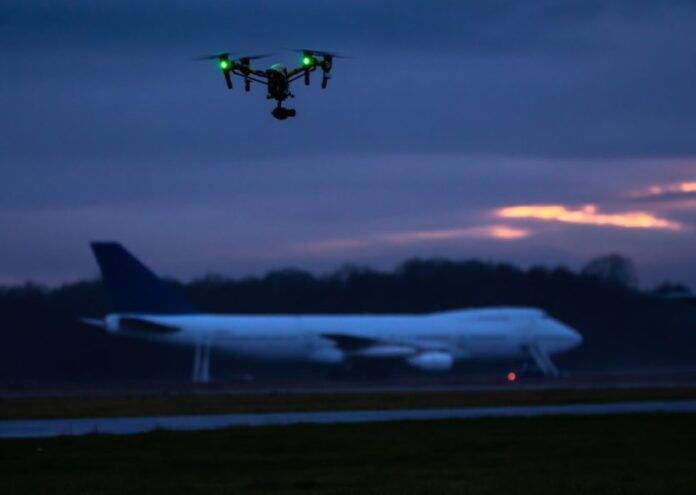
Airports differ in size, capacity, air traffic, and proximity to populated areas. But some hazards associated with drones or unmanned aerial vehicles (UAVs) are common to all airports.
Drone incidents at critical infrastructures like airport facilities are rapidly increasing in frequency, complexity, and severity, as drones become larger, more powerful and cheaper, posing a wide range of practical, legal, and policy challenges in airport’s environment.
Therefore, it is critical to deploy countermeasures to protect airports from aerial attacks and unwanted drone activities such as spying and tracking points of interest, conducting unauthorized mapping or surveillance through an effective vulnerability assessment, risk management, and resilience actions.
In the previous post, we read about four types of sensor technologies used by airport authorities to identify unauthorized drone presence near the airports. We have also seen the pros and cons of these commercially available C-UAS detection technologies. Today, we will discuss five counter-drone techniques used by airports as mitigation countermeasures to stop drones from invading airport premises.
1. Electronic interdiction or signal jamming
Electronic interdiction or signal jamming is an intentional use of RF transmission to block signals and disrupt communications between the GSC operator and the flying UAV. This results in the following reactions, depending on the drone’s design:
- the drone makes a controlled landing in its current position
- the drone returns to a user-set home location
- the drone falls uncontrolled to the ground
- the drone flies off in a random unchecked direction.
a. RF Jamming
A static, mobile, or handheld radio-frequency jammer transmits a large amount of RF energy towards the drone, masking the controller signal and preventing the operator from maneuvering the drone.
Pros
- Use RF transmission to block signals and disrupt C2 between the GSC operator and UAV
- Medium range up to a few kilometers, depending on emitting power.
- Static, mobile, or handheld device
- Programmable based on RF sensor scanning
- Disrupts radio-frequency (RF) communication links and can include Wi-Fi links
- Use of directional jamming to minimize interfering
Cons
- RF interference in crowded RF areas. May also jam and interrupt other communication signals.
- Cannot affect autonomous driven drones (without an active RF link)
- Illegal in many countries
- May cause uncontrolled UAV flights and crashes
- Needs special licensing for approved use, based on electromagnetic compatibility regulations
- A jammer’s ability relies on the strength of its radio transmitter.
b. GPS Jamming
GPS jamming is useful when UAVs use GPS navigation systems for navigation. Mitigating a satellite-navigated drone is a much larger challenge than jamming an RF-controlled drone. To effectively jam a satellite navigation signal, a stronger signal is sent to the drone, replacing the GPS communication.
Pros
- Replaces GPS communication, increases the difficulty of controlling the drone.
- Medium to short-range, depending on the satellite constellation
- Disrupts Global Positioning Satellite communication link
- Prevents return-to-home functionality
Cons
- Cannot work if UAVs disable GPS or use encrypted GPS (military mission)
- Dangerous when used near airports, because airplanes also use satellite navigation
- Illegal procedure in many countries. Needs special licensing for approved use
- May cause uncontrolled UAV flights and crashes
c. Protocol Manipulation
Protocol manipulation means to take control of a UAS by impersonating its remote control. In this method, signal instructions are emitted to confuse the UAS so that the manipulated signal is conceived as legitimate.
Pros
- Replaces the communication link and takes control of drone operation
- Employ algorithms enhanced with artificial intelligence.
- Can drive a malicious UAV to a designated area
- The low-cost technique, based on attackers’ ability
Cons
- Illegal procedures for civilian use acts against computer fraud and abuse.
- Not always successful, primarily when encryption is used for C2 links
- A complicated method, not always successful.
- Cannot affect autonomous driven UAVs not using GPS
2. Kinetic Interdiction
There are many types of kinetic options proposed by researchers and industry today.
a. Physical – Net Capturing and Birds of Prey
Net capturing is an attempt to physically capture a drone. An enforced and hardened UAV flies toward the intruding drone and carries attack nets to seize and bring back the targeted UAS. Such systems work relatively short distances and are effective when the nefarious drone navigates with a low speed or does not maneuver.
Birds of prey are trained birds with protective gear, which are used to attack and grab UAS when entering a restricted area. However, birds are restricted and pose hazards when flying around airport areas due to possible conflicts with arriving or landing aircraft.
Pros
- Active and aggressive countermeasures
- Net capturing: enforced and hardened UAVs physically capture a drone
- Birds of prey are used to attack and grab UAS
- Captures and drives UAVs in a specific area
Cons
- May cause collateral fatalities to other aircraft. Not appropriate for airports
- Net capturing efficiency depends on UAVs’ flight behavior, reaction time, etc.
- Birds also pose hazards when flying around airports.
- Depends on speed or maneuvering capabilities of rogue UAVs
b. Electronic – Microwave or Laser Guns
High-power microwave (HPM) or laser guns use high-power electromagnetic pulse or laser to target and shoot down UAVs. HPM or high-energy lasers destroy electronic circuits and other vital segments of the drone’s airframe, causing UAVs to crash.
Pros
- Aggressive and long-range countermeasures
- Destroys electronic systems of UAVs
- Disables drone flight
Cons
- Can have adverse effects on other passing aircraft with fatal consequences
- May cause uncontrolled UAV flights and crashes
- Illegal in civil aviation contexts. Violates aviation security laws
In many countries, mitigation counter-drone systems are not allowed in civilian environments, but only when applied by police and military operations. Most governments are yet to establish comprehensive C-UAS-specific policies for protecting aviation assets. The airspace regulators continue to develop regulations for UAVs’ integration into commercial and civilian uses.






















